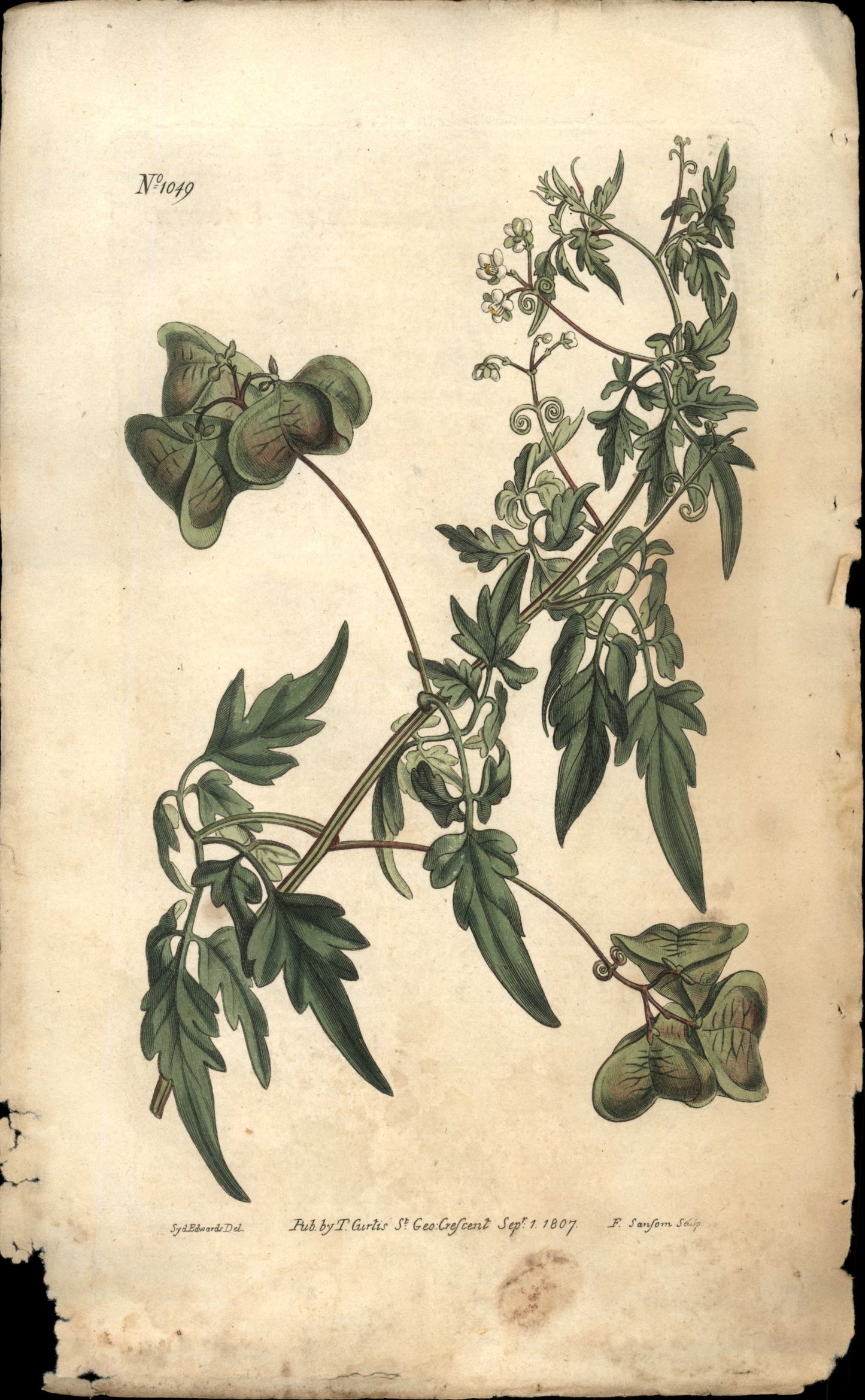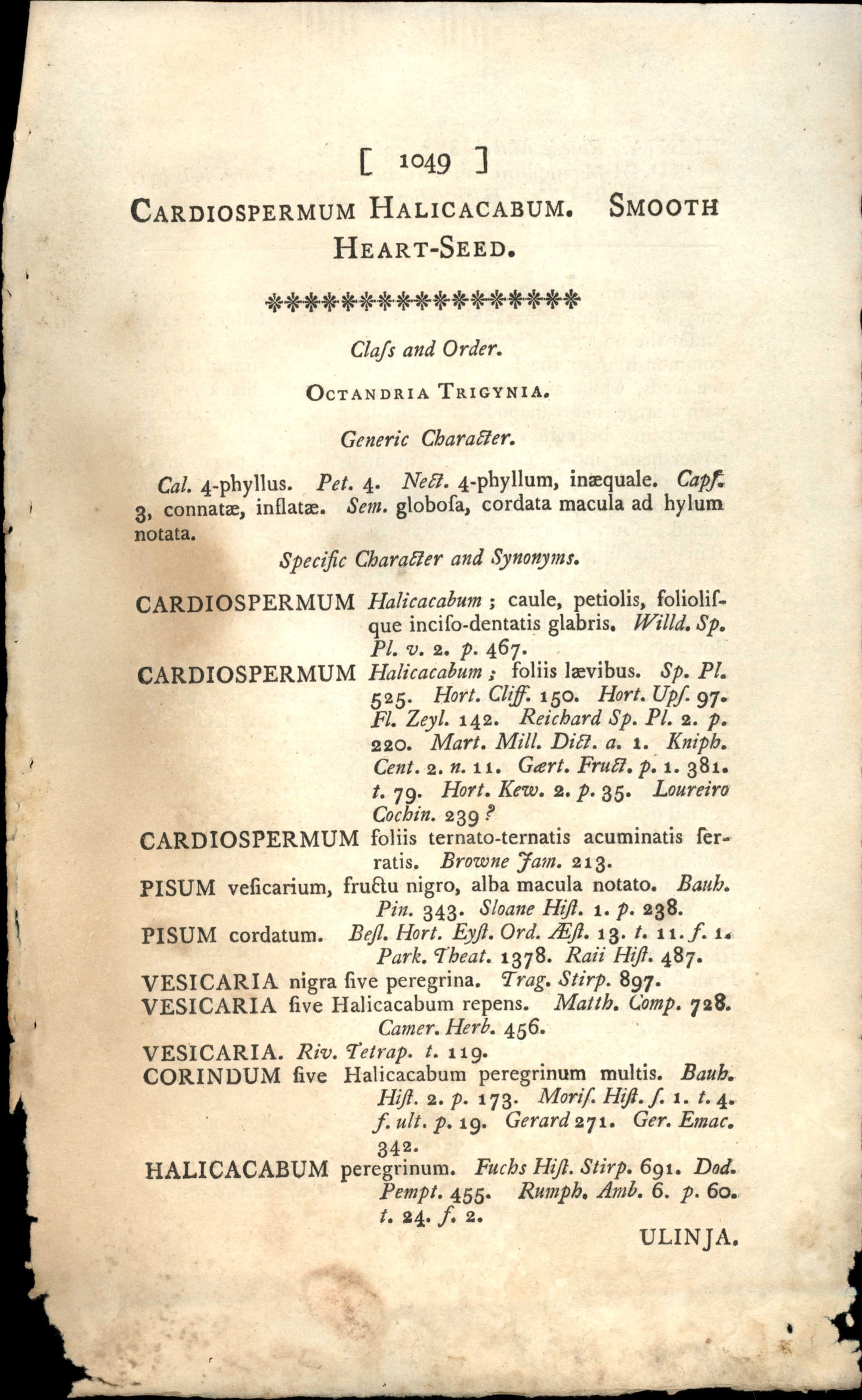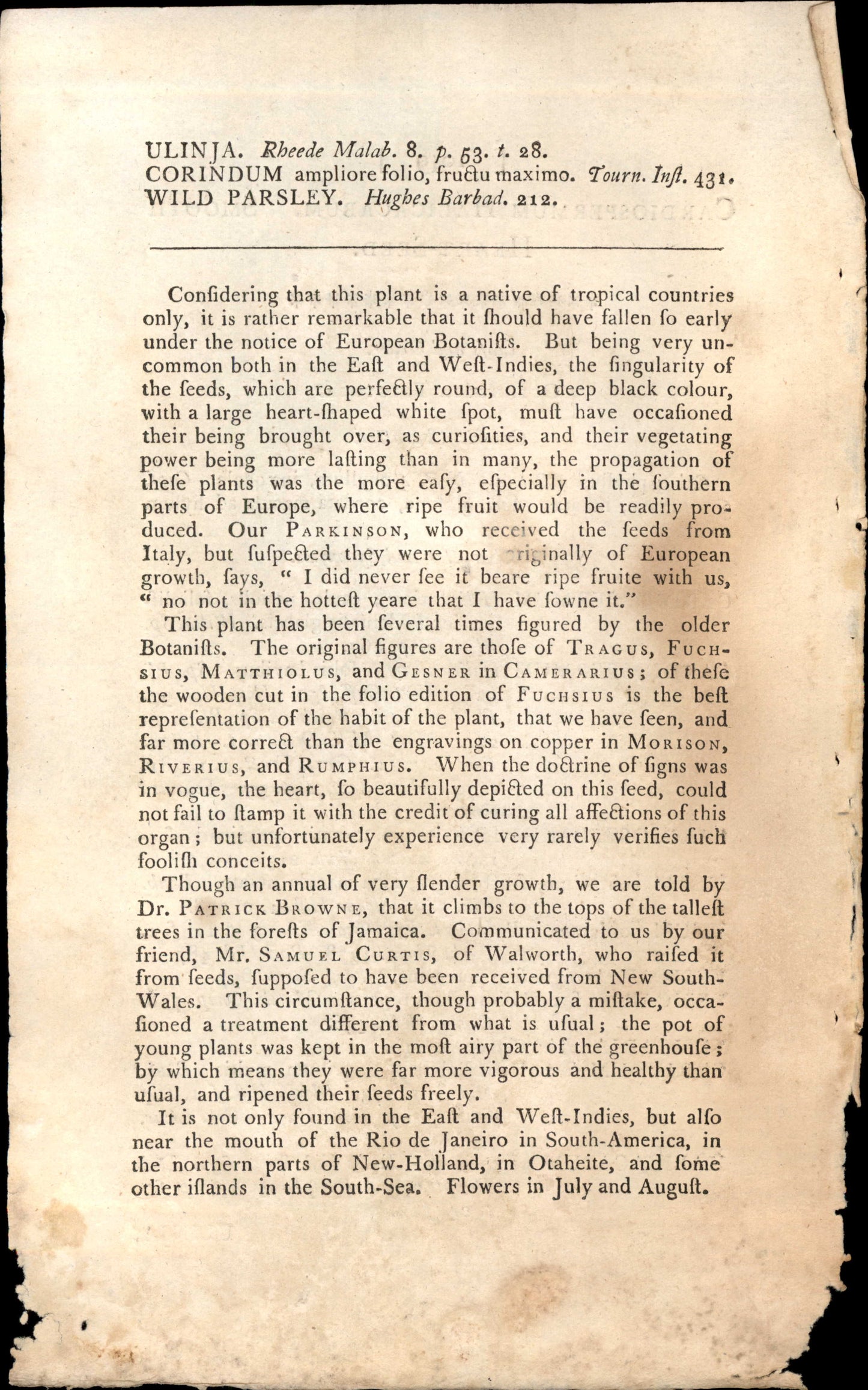Curtis Botanical Magazine
Plate 1049 - Octandria Trigynia
Plate 1049 - Octandria Trigynia
Couldn't load pickup availability
Plate 1049
Publication Information
Publisher Line: rds Del. Pub by T. Gurtis st Geo:st Geo Crescent Sep 1. 1807
Artist: Edwards del. (delineavit - drawn by)
Publisher: T. Gurtis
Location: Walworth
Publication Date: Sep 1. 1807
Native Region: America, Europe, West Indies, Italy
Flowering Period: July - August
Description: [ 1049 ] CARDIOsPERMUM HALICACABUM. smooth HEART-SEED.
Class and Order
OCTANDRIA TRIGYNIA.
Generic Character
. Cal. 4-phyllus. Pet. 4. Nect. 4-phyllum, inæquale. Caps. 3, connatæ, inflatæ. Sem. globofa, cordata macula ad hylum notata.
Specific Character and Synonyms
. CARDIOsPERMUM Halicacabum; caule, petiolis, soliolif- que inciso-dentatis glabris. Willd. sp. Pl. v. 2. p. 467. CARDIOsPERMUM Halicacabum; soliis lævibus. sp. Pl. 525. Hort. Cliff. 150. Hort. Upf. 97- Fl. Zeyl. 142. Reichard sp. Pl. 2. p. 220. Mart. Mill. Dict. a. 1. Kniph. Cent. 2. n. 11. Gært. Fruct. p. 1. 381. 79. Hort. Kew. 2. p. 35. Loureiro Cochin. 239 ? t. CARDIOsPERMUM soliis ternato-ternatis acuminatis fer- ratis. Browne Jam. 213. PISUM veficarium, fructu nigro, alba macula notato. Bauh. Pin. 343. sloane Hist. 1. p. 238. PISUM cordatum. Befl. Hort. Eyft. Ord. Eft. 13. t. 11. f. 1. Park. Theat. 1378. Raii Hist. 487. VESICARIA nigra five peregrina. Trag. stirp. 897. VESICARIA five Halicacabum repens. Matth. Comp. 728. Camer. Herb. 456. VESICARIA. Riv. Tetrap. t. 119. CORINDUM five Halicacabum peregrinum multis. Bauh. Hist. 2. p. 173. Morif. Hist. f. 1. t. 4. f. ult. p. 19. Gerard 271. Ger. Emac. 342. HALICACABUM peregrinum. Fuchs Hist. stirp. 691. Dod. Pempt. 455. Rumph. Amb. 6. p. 60. t. 24. f. 2. ULINJA. ULINJA. Rheede Malab. 8. p. 53. t. 28. CORINDUM ampliore solio, fructu maximo. Tourn. Inft. 431. WILD PARsLEY. Hughes Barbad. 212.
Considering that this plant is a native of tropical countries only, it is rather remarkable that it should have fallen so early under the notice of European Botanists. But being very un- common both in the Eaft and Weft-Indies, the singularity of the seeds, which are perfectly round, of a deep black colour, with a large heart-shaped white spot, must have occafioned their being brought over, as curiosities, and their vegetating power being more lasting than in many, the propagation of these plants was the more easy, especially in the southern parts of Europe, where ripe fruit would be readily pro- duced. Our PARKINSON, who received the seeds from Italy, but suspected they were not riginally of European growth, says, " I did never fee it beare ripe fruite with us, no not in the hotteft yeare that I have sowne it." This plant has been several times figured by the older Botanists. The original figures are those of TRAGUS, FUCH- SIUS, MATTHIOLUS, and GEsNER in CAMERARIUS; of these the wooden cut in the solio edition of FUCHSIUS is the best representation of the habit of the plant, that we have seen, and far more correct than the engravings on copper in MORISON, RIVERIUS, and RUMPHIUS. When the doctrine of signs was in twogue, the heart, so beautifully depicted on this seed, could not fail to ftamp it with the credit of curing all affections of this organ; but unfortunately experience very rarely verifies such soolish conceits. Though an annual of very slender growth, we are told by Dr. PATRICK BROWNE, that it climbs to the tops of the talleft trees in the forefts of Jamaica. Communicated to us by our friend, Mr. SAMUEL CURTIS, of Walworth, who raised it from seeds, supposed to have been received from New South- Wales. This circumstance, though probably a miftake, occa- fioned a treatment different from what is usual; the pot of young plants was kept in the most airy part of the greenhouse; by which means they were far more vigorous and healthy than usual, and ripened their seeds freely. It is not only found in the Eaft and Weft-Indies, but also near the mouth of the Rio de Janeiro in South-America, in the northern parts of New-Holland, in Otaheite, and some other islands in the South-Sea. Flowers in July and August. N°1049
syd Edwards Del.
Pub by T. Gurtis st Geo:st Geo st Geo st Geo Crescent Sep 1. 1807. F. E. E. Sansom Sep
Raw OCR Text (Original)
[ 1049 ] CARDIOsPERMUM HALICACABUM. smooth HEART-SEED. ***************** Class and Order. OCTANDRIA TRIGYNIA. Generic Character. Cal. 4-phyllus. Pet. 4. Nect. 4-phyllum, inæquale. Caps. 3, connatæ, inflatæ. Sem. globofa, cordata macula ad hylum notata. specific Character and synonyms. CARDIOsPERMUM Halicacabum; caule, petiolis, soliolif- que inciso-dentatis glabris. Willd. sp. Pl. v. 2. p. 467. CARDIOsPERMUM Halicacabum; soliis lævibus. sp. Pl. 525. Hort. Cliff. 150. Hort. Upf. 97- Fl. Zeyl. 142. Reichard sp. Pl. 2. p. 220. Mart. Mill. Dict. a. 1. Kniph. Cent. 2. n. 11. Gært. Fruct. p. 1. 381. 79. Hort. Kew. 2. p. 35. Loureiro Cochin. 239 ? t. CARDIOsPERMUM soliis ternato-ternatis acuminatis fer- ratis. Browne Jam. 213. PISUM veficarium, fructu nigro, alba macula notato. Bauh. Pin. 343. sloane Hist. 1. p. 238. PISUM cordatum. Befl. Hort. Eyft. Ord. Eft. 13. t. 11. f. 1. Park. Theat. 1378. Raii Hist. 487. VESICARIA nigra five peregrina. Trag. stirp. 897. VESICARIA five Halicacabum repens. Matth. Comp. 728. Camer. Herb. 456. VESICARIA. Riv. Tetrap. t. 119. CORINDUM five Halicacabum peregrinum multis. Bauh. Hist. 2. p. 173. Morif. Hist. f. 1. t. 4. f. ult. p. 19. Gerard 271. Ger. Emac. 342. HALICACABUM peregrinum. Fuchs Hist. stirp. 691. Dod. Pempt. 455. Rumph. Amb. 6. p. 60. t. 24. f. 2. ULINJA. ULINJA. Rheede Malab. 8. p. 53. t. 28. CORINDUM ampliore solio, fructu maximo. Tourn. Inft. 431. WILD PARsLEY. Hughes Barbad. 212. Considering that this plant is a native of tropical countries only, it is rather remarkable that it should have fallen so early under the notice of European Botanists. But being very un- common both in the Eaft and Weft-Indies, the singularity of the seeds, which are perfectly round, of a deep black colour, with a large heart-shaped white spot, must have occafioned their being brought over, as curiosities, and their vegetating power being more lasting than in many, the propagation of these plants was the more easy, especially in the southern parts of Europe, where ripe fruit would be readily pro- duced. Our PARKINSON, who received the seeds from Italy, but suspected they were not riginally of European growth, says, " I did never fee it beare ripe fruite with us, no not in the hotteft yeare that I have sowne it." This plant has been several times figured by the older Botanists. The original figures are those of TRAGUS, FUCH- SIUS, MATTHIOLUS, and GEsNER in CAMERARIUS; of these the wooden cut in the solio edition of FUCHSIUS is the best representation of the habit of the plant, that we have seen, and far more correct than the engravings on copper in MORISON, RIVERIUS, and RUMPHIUS. When the doctrine of signs was in twogue, the heart, so beautifully depicted on this seed, could not fail to ftamp it with the credit of curing all affections of this organ; but unfortunately experience very rarely verifies such soolish conceits. Though an annual of very slender growth, we are told by Dr. PATRICK BROWNE, that it climbs to the tops of the talleft trees in the forefts of Jamaica. Communicated to us by our friend, Mr. SAMUEL CURTIS, of Walworth, who raised it from seeds, supposed to have been received from New South- Wales. This circumstance, though probably a miftake, occa- fioned a treatment different from what is usual; the pot of young plants was kept in the most airy part of the greenhouse; by which means they were far more vigorous and healthy than usual, and ripened their seeds freely. It is not only found in the Eaft and Weft-Indies, but also near the mouth of the Rio de Janeiro in South-America, in the northern parts of New-Holland, in Otaheite, and some other islands in the South-Sea. Flowers in July and August. N°1049 syd Edwards Del. Pub by T. Gurtis st Geo:st Geo st Geo Crescent Sep 1. 1807. F. E. Sansom Sep
Plate Period: 1808-1810 - Mixed artist period
Typical Artists: S Curtis Del, W.J.H.del
Expected Publisher: S Curtis at Walworth
Publisher Location: Walworth, London - another Curtis publishing location
Artist Information: delineavit (Latin: 'drawn by') - indicates the artist who drew the botanical illustration
Original botanical print from Curtis's Botanical Magazine
Share







